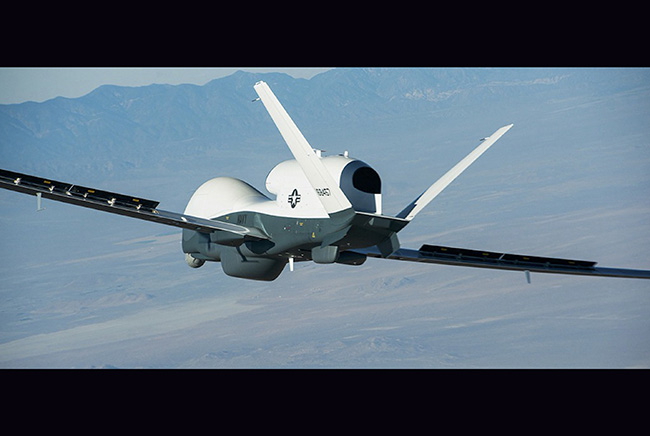
The Northrop Grumman-built Triton unmanned aircraft system completed its first flight from the company’s manufacturing facility in Palmdale, Calif., May 22, 2014. Northrop Grumman photo by Bob Brown via the US Navy.
Even though Iran claims to have recovered portions of the US Navy drone it shot down over the Strait of Hormuz on June 19, it’s unlikely the country will be able to gather much US military technical intelligence from the aircraft.
“The critical elements … the Iranians might benefit from are not the actual structural elements of the aircraft; there’s nothing classified about that,” retired Lt. Gen. David Deptula, dean of AFA’s Mitchell Institute, told Air Force Magazine. “It would be elements from the sensors that the BAMS-D aircraft were actually flying.”
Even though the US government is staying tight-lipped about what those sensors were, he suspects the damage incurred from the surface-to-air missile blast, “which tears apart equipment,” and the resulting descent from an altitude “as high as 50,000 feet, smack in the ocean” would cause too much damage for them to be useful. Deptula said “parts and pieces” of the Global Hawk variant that have appeared on television in the wake of the attack “are pretty mangled and destroyed.”
But that doesn’t mean that unmanned aircraft should stop operating in the region. In fact, Deputula said he would put an additional Global Hawk “in the exact same track” as the downed drone, since no nation should be scared away from flying in international airspace and “we certainly don’t want to be cowed into that position.”
When asked at a June 26 AFA Mitchell Institute breakfast about the enduring viability of unmanned aircraft in contested airspace, Air Force Chief of Staff Gen. David Goldfein said aircraft will continue patrolling the Persian Gulf. He doesn’t expect to significantly change the combination of assets in the region, noting it’s his job to pull together combat options for President Donald Trump if needed.
“We continue to fly where we need to be, when we need to be there, as we do in all scenarios,” he said. “This is a conversation we could have anywhere in terms of international airspace. … We continue to protect those global commons for everyone and we continue to operate where we need to operate.”
Iran’s SAM capability was well known before the attack, but what wasn’t known before was “that they would violate the rules of international governance by shooting down an unarmed aircraft in international airspace,” Deptula noted.
The attack underscores the urgency of speeding procurement and recapitalizing “our geriatric Air Force with systems that have been designed to operate against high-threat capabilities like stealth fighters, bombers, and ISR aircraft,” because it’s no longer safe to assume that all US military air operations will occur in permissive territory, Deptula added. State-of-the-art air-defense systems and contested airspace must also be taken into account.
“The presumption of being able to operate in permissible airspace is one that was legitimate over the last quarter of a century, but this shootdown demonstrates the consequences of operating against even second-rate military powers,” he said.
Dan Gettinger, co-director of the Center for the Study of the Drone at Bard College, said the current direction of US drone strategy, technological development, and acquisition favor equipping future military unmanned aerial vehicles with the toughness these kinds of contested environments demand.
Gettinger noted that today’s remotely piloted aircraft are mostly designed for a “very specific theater” or a counterterrorism mission. Although he acknowledged they can be “adapted for conflict against a near-peer competitor, … the direction that this technology is going and the direction that the US is going from a strategic point of view and an acquisition point of view is towards developing the next generation of drones … to be more survivable in these types of situations.”